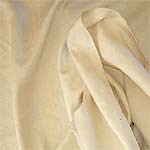Silk is made from the unwound cocoons of a particular group of moths. The oldest silks date back to 1500 BCE in China, although the word “silk” in Chinese is known to be older than that. The establishment of the Silk Road between 140-60 CE marks the beginning of silk use in the West.
Silk feels gorgeous, however unless you are portraying someone extremely wealthy (and have all the accessories to go with your', 'outfit) it would not be recommended to make an entire garment out of silk. The most common use for silk in our era was for trims (collars, cuffs, and decorative accents).
Fabric Types
There are many types of silk available to us today, and they differ in quality and price, however the following are ones that are known to be of our period.
Noil (Raw Silk)
Often called “raw silk”, Noil is characterised by a nubbly texture and the subtle flecks that are actually particles from the silkworm’s cocoon. It has a muted sheen, resists wrinkles, is softer than linen and is excellent for clothing.
Habutai
This silk is soft, lightweight and lustrous with a smooth surface. It means “soft and downy” in Japanese and is a very versatile silk fabric.
Samite
Twill-faced patterned silk. This was the weave used in ancient Persian and Byzantine figured silks.
Care
Silk is a fibre made of protein like wool or hair, therefore some detergents that are made to dissolve protein stains may weaken silk over time. It can be washed, however it is recommended garments be washed by hand. Try a baby shampoo or use soap which is different in chemical composition than a detergent.
Dry cleaning is optimal as some silk dyes used during manufacturing may lose their brilliance through normal washing.
How it is Made
Silk thread is obtained by carefully unravelling silk worm cocoons and reeling the silk onto spools. First the cocoons are soaked in water to make them easier to reel, then the start of each thread is found - one thread per cocoon. Michael Cook from Wormspit states that an ounce of reeled raw silk is equivalent to about 250 cocoons and can be created in an evenings work.
Silk can also be made by spinning. The cocoons need to be degummed and carded, much like wool.
Additional Information
Virtue Ventures - Silk
Winter Fabrics - Silk Types
Worm Spit
Subscribe to:
Post Comments (Atom)


No comments:
Post a Comment